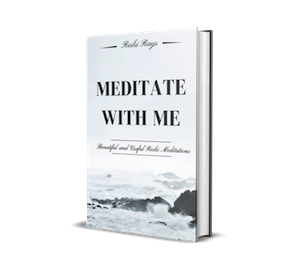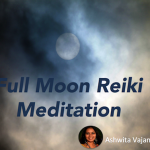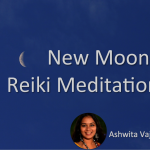One of the fundamentals of Reiki is to connect with one’s self spiritually, or to one’s soul. Dr. Usui taught his students Hatsurei Ho: Hatsu meaning to bring forth, Rei meaning spirit and Ho meaning method. The Hatsurei method plays an important part in the Reiki practice. It’s a meditation technique, but it stands out as different from other techniques through the gestures made and words spoken.
Below are the steps, or stages, to perform this method. It can be practiced either individually or in a group. When practiced in a group, it is called Shuyo ho. Hatsurei Ho consists of nine stages, each stage helps in clearing and opening the energy levels in the process.

Image by rkramer62
STAGE ONE: Relax
Seat yourself in a Sieza position or sit up straight in a still yet comfortable position and place your hands palm down on your thighs or in your lap. Close your eyes and concentrate on your core or center of your body (between your abdomen and pubic bone).
STAGE TWO: Mokunen
Mokunen means “focusing”, which requires the individuals complete focused state and declaration in low voice that “I will now begin Hatsurei Ho.”
STAGE THREE: Kenyoku
Kenyoku means “Dry bathing”. In this process, the negative aura is brushed off either by an actual physical touch or just superficially. In this procedure, you basically attempt to “disconnect” yourself from every being, emotion, thoughts, and energy – preparing to enter the meditation state.
Start by relaxing your breathing by inhaling through your nose and exhaling through your mouth. Place your right hand on your left shoulder, your finger touching the joint between the end of your collar bone and shoulder. With palm faced towards the body; while exhaling, smooth your hand down diagonally across your chest to your right hip. Repeat this procedure with your left hand placed on your right shoulder; fingers touching the joint between the end of the collar bone and shoulder. Palm facing your body, exhale while brushing down diagonally across your chest to your left hip. Repeat twice in same order.
Now stretch your left hand forward in front of you and place your right hand fingertips on the edge of your left shoulder. With the palm flattened, move your right hand down along the side of your left arm while exhaling. Repeat this process with your right arm, completing the cycle three times.
STAGE FOUR: Connect to Reiki
Move your hands up above your head, aligned with your shoulders with your palms facing upwards and fingers pointing towards each other. With your mind clear, now feel the Reiki energy or white aura flowing down from above through your arms and into your body. Once you sense the Reiki energy, slowly lower your hands.
STAGE FIVE: Joshin Kokkyu Ho
Joshin Kokkyu Ho is a procedure of purifying the soul through a breathing process. Place your hands, palm up on your lap and in a relaxed manner, breath slowly through your nose while focusing on your “seika tanden” or core. With natural breathing, feel the white lighted Reiki energy flow from your mind into your center. Slowly feel the energy spread in your entire body, dissolving all negativity and unlimitedly expanding around you.
STAGE SIX: Gassho
Gassho, meaning joined hands requires you to hold your hands together as if you were praying in front of your chest. Concentrate on connection of your middle fingers and hold yourself in this position.
STAGE SEVEN: Seishin Toitsu
Still in the Gassho position with mind and soul gathered, breath in white Reiki energy passing through your hands to your tanden. When you breathe out, imagine the energy flow out from your core and through your hands. (This is the stage where the Reiju is given to students by teachers).
STAGE EIGHT: Gokai Sansho
Gokai Sansho consists of five fundamentals for the day that are spoken out loud and repeated three times. The Fundamentals are:
Kyo dake wa – Just for today
Okoru na – Avoid anger
Shinpai suna – Stop worrying
Kansha shite – Be thankful
Gyo o hage me – work with effort and sincerity
Hito ni shinsetsu ni – Be friendly and kind hearted to all
STAGE NINE: Mokunen
Bring your hands back to your lap, palm faced down and say, “I conclude Hatsurei Ho.”
You’re done :).
Free eBook download: We’ve created an eBook with our best articles on this topic, and offer it for free to all our newsletter subscribers.






it would be great if you could support this with drawings of positions and movements… i could not understand how hands are to be positioned for stage four.
thanks for this article.
Thanks for the suggestion! It’s on the TODO list now 🙂
My website has Hatsurei Ho with pictures, including the Connect to Reiki position.
http://www.kaizenreiki.com/hatsurei-ho-the-jewel-of-reiki/
This was exactly what I needed as I am studying Kundalini Reiki and this method was mentioned but there was no explanation given. Thanks for filling in the blank for me!
After trying this meditation for the first time I felt (must say this) Love. There was a sense of calm and completeness that I had lost touch with in the busy-ness of days. And as often happens when Reiki is involved …at stage four when I lifted my hands above my head it began to rain so not only was I sensing the Reiki flowing into me but I heard if affirmed outside…music from the Universe
Amazing… Gotta (re)start doing this meditation, thanks for the reminder…
A Ja to oczyszczanie juz znalam wczwsniej z tym ze pod nazwa Anielskie
; ) jest super …
Always love to learn about reiki! Thank you 🙂
Thanks for sharing. Yes, this meditation has been around for some time in the West.
My only change would be the pronunciation for DO NOT ANGER
Instead of Okoru na – I’ve heard it said Ikaruna
My limited understanding of Japanese has lead me to believe the ‘I’ stands for not
and the karuna part is for compassion.
Take care,
Hello, Lorinda
Okoru na – consists of 2 parts:
– okoru means “anger”
– na means “don’t”
The article is beautiful. Thanks!
Thanks for reminding me again this beautiful techniques I almost forgotten. may you all be filled with love & lights.
Beautiful! Can’t wait to try it!
If possible plz send guided audio podcast of this meditation technique.
Thank you for sharing. I have found this video – the visuals may help us understanding it in a better way.
https://www.youtube.com/watch?v=_aLLAhro6zo
The video is great but it would be Awesome if it were in the English Language. Thank you
Good article but the pop-ups on this site are a huge distraction.